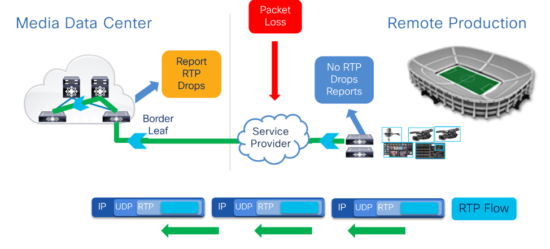If you’re in the media industry, you know why the move from serial digital interfaces (SDI) to IP can be so stressful.
Leveraging IP for broadcasting in studios, stadiums and trucks dramatically simplifies and optimizes infrastructure setup and work flows and opens innovative ways of doing remote production. But, troubleshooting when an IP packet is lost in the whole chain can be a daunting task. Packet loss results in bad video signal and that can quickly become an operator’s nightmare.
Even though IP networks are designed to ensure resiliency with multiple paths from source to destination, interface errors and drops are generally beyond an operator’s control.
Back when you were using SDI infrastructure, you were dealing with one-to-one connections, so it was relatively easy to detect the source of a problem. But with an IP infrastructure multiple signals are going through the cable, so it’s hard to tell where the problem may lie. Is it between the remote feed and the production facility? Or at the service provider? Or in the production facility itself? Figuring out the source of a problem can be difficult.
The Cisco Nexus 9000 can help
Fortunately, there’s a solution. When you build your IP infrastructure with Nexus 9000 series switches, the Media Flow Analytics capability built into these switches monitors the health of the video flows and alerts you when the packet loss happened, on what link, how many packets were lost and at what time. The traditional way to check network health involved polling each network element for link errors, but the Nexus 9000 uses hardware and software streaming telemetry capabilities to proactively identify and notify operators of traffic problems, usage, and resource utilization.
What this technology means for you as an operator is that resolving problems goes from hours to seconds. You can detect packet loss quickly because you know exactly where it’s happening.
For example, suppose content that is captured at a stadium is transported to a production facility across a service provider network. The IP network has a Cisco Nexus 9000 at the stadium and one at the production network. When bad video appears on screen, the Media Flow Analytics feature notifies the operator where the issue is taking place.

If the Nexus 9000 at the stadium reports no issues, but the Nexus 9000 at the production edge toward the service provider does report an issue, you can conclude that the service provider is dropping the packet as shown in the figure above.
Learn more
Cisco offers the media industry a reliable, scalable, and flexible network and provides the tools you need to efficiently operate that network. To learn more about how to keep your IP network video flows running smoothly, read our new white paper: “Media Flow Analytics: Using the Cisco Nexus 9000 for media flow health monitoring.”

CONNECT WITH US